Management Accounting Report: Planning, Costing, and Financial Issues
VerifiedAdded on 2020/11/23
|16
|5084
|485
Report
AI Summary
This report provides a comprehensive analysis of management accounting principles and practices. It begins with an introduction to management accounting, highlighting its essential requirements and benefits, including the importance of effective accounting systems for recording financial transactions and achieving organizational goals. The report then delves into various costing techniques, such as normal, standard, and actual costing, along with inventory management systems like LIFO and FIFO, and job-costing systems, all of which are crucial for calculating net income and making informed business decisions. Furthermore, it explores the merits and demerits of planning tools used in budgeting, offering insights into how these tools can be utilized to manage and control financial issues within an organization. The report also examines different types of management reporting, including performance reports, inventory management reports, and job cost reports, emphasizing their role in evaluating financial performance and making strategic decisions. Overall, the report provides a detailed overview of management accounting, covering costing, planning, and financial analysis, and the effective use of accounting systems to resolve financial problems.
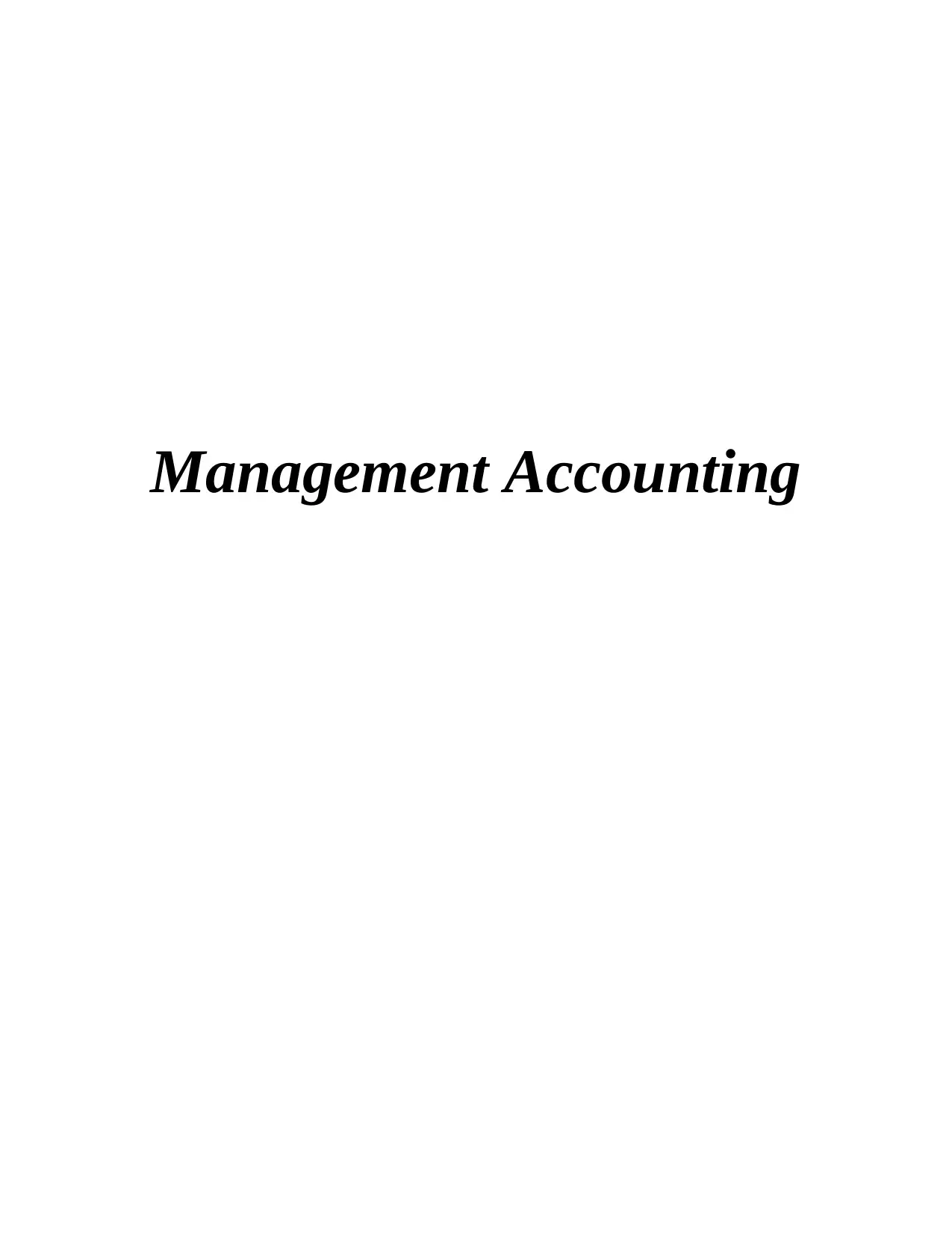
Management Accounting
Paraphrase This Document
Need a fresh take? Get an instant paraphrase of this document with our AI Paraphraser
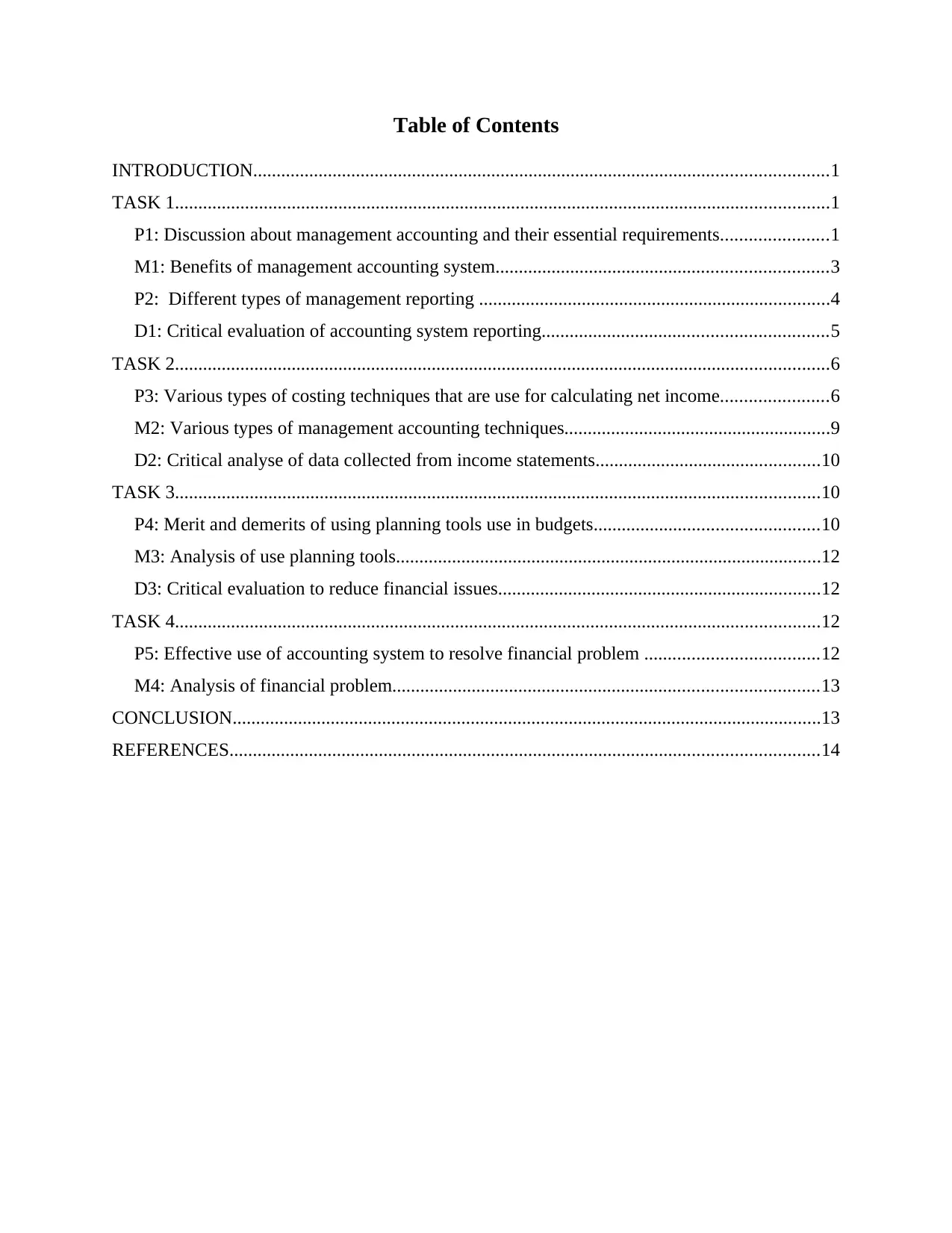
Table of Contents
INTRODUCTION...........................................................................................................................1
TASK 1............................................................................................................................................1
P1: Discussion about management accounting and their essential requirements.......................1
M1: Benefits of management accounting system.......................................................................3
P2: Different types of management reporting ...........................................................................4
D1: Critical evaluation of accounting system reporting.............................................................5
TASK 2............................................................................................................................................6
P3: Various types of costing techniques that are use for calculating net income.......................6
M2: Various types of management accounting techniques.........................................................9
D2: Critical analyse of data collected from income statements................................................10
TASK 3..........................................................................................................................................10
P4: Merit and demerits of using planning tools use in budgets................................................10
M3: Analysis of use planning tools...........................................................................................12
D3: Critical evaluation to reduce financial issues.....................................................................12
TASK 4..........................................................................................................................................12
P5: Effective use of accounting system to resolve financial problem .....................................12
M4: Analysis of financial problem...........................................................................................13
CONCLUSION..............................................................................................................................13
REFERENCES..............................................................................................................................14
INTRODUCTION...........................................................................................................................1
TASK 1............................................................................................................................................1
P1: Discussion about management accounting and their essential requirements.......................1
M1: Benefits of management accounting system.......................................................................3
P2: Different types of management reporting ...........................................................................4
D1: Critical evaluation of accounting system reporting.............................................................5
TASK 2............................................................................................................................................6
P3: Various types of costing techniques that are use for calculating net income.......................6
M2: Various types of management accounting techniques.........................................................9
D2: Critical analyse of data collected from income statements................................................10
TASK 3..........................................................................................................................................10
P4: Merit and demerits of using planning tools use in budgets................................................10
M3: Analysis of use planning tools...........................................................................................12
D3: Critical evaluation to reduce financial issues.....................................................................12
TASK 4..........................................................................................................................................12
P5: Effective use of accounting system to resolve financial problem .....................................12
M4: Analysis of financial problem...........................................................................................13
CONCLUSION..............................................................................................................................13
REFERENCES..............................................................................................................................14
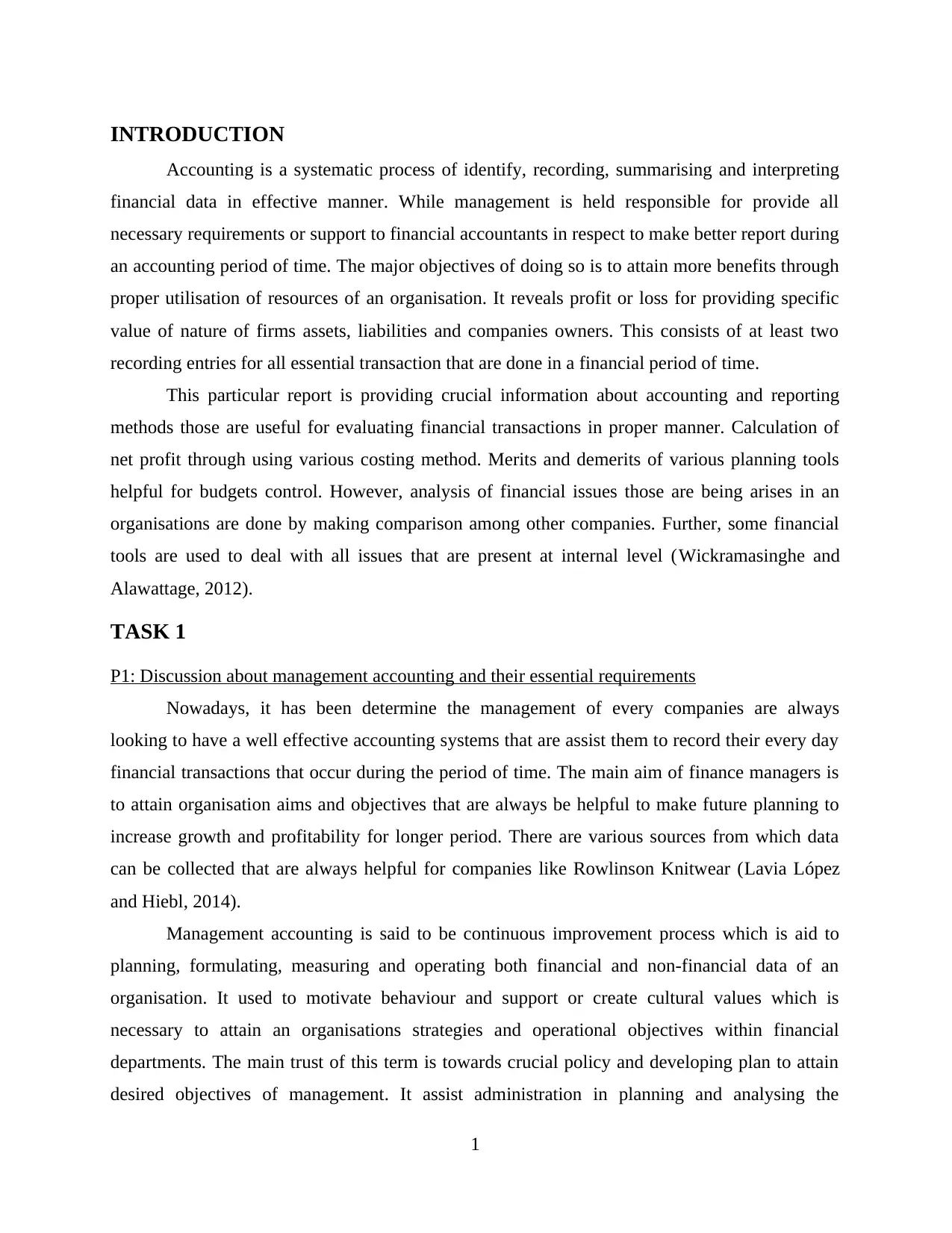
INTRODUCTION
Accounting is a systematic process of identify, recording, summarising and interpreting
financial data in effective manner. While management is held responsible for provide all
necessary requirements or support to financial accountants in respect to make better report during
an accounting period of time. The major objectives of doing so is to attain more benefits through
proper utilisation of resources of an organisation. It reveals profit or loss for providing specific
value of nature of firms assets, liabilities and companies owners. This consists of at least two
recording entries for all essential transaction that are done in a financial period of time.
This particular report is providing crucial information about accounting and reporting
methods those are useful for evaluating financial transactions in proper manner. Calculation of
net profit through using various costing method. Merits and demerits of various planning tools
helpful for budgets control. However, analysis of financial issues those are being arises in an
organisations are done by making comparison among other companies. Further, some financial
tools are used to deal with all issues that are present at internal level (Wickramasinghe and
Alawattage, 2012).
TASK 1
P1: Discussion about management accounting and their essential requirements
Nowadays, it has been determine the management of every companies are always
looking to have a well effective accounting systems that are assist them to record their every day
financial transactions that occur during the period of time. The main aim of finance managers is
to attain organisation aims and objectives that are always be helpful to make future planning to
increase growth and profitability for longer period. There are various sources from which data
can be collected that are always helpful for companies like Rowlinson Knitwear (Lavia López
and Hiebl, 2014).
Management accounting is said to be continuous improvement process which is aid to
planning, formulating, measuring and operating both financial and non-financial data of an
organisation. It used to motivate behaviour and support or create cultural values which is
necessary to attain an organisations strategies and operational objectives within financial
departments. The main trust of this term is towards crucial policy and developing plan to attain
desired objectives of management. It assist administration in planning and analysing the
1
Accounting is a systematic process of identify, recording, summarising and interpreting
financial data in effective manner. While management is held responsible for provide all
necessary requirements or support to financial accountants in respect to make better report during
an accounting period of time. The major objectives of doing so is to attain more benefits through
proper utilisation of resources of an organisation. It reveals profit or loss for providing specific
value of nature of firms assets, liabilities and companies owners. This consists of at least two
recording entries for all essential transaction that are done in a financial period of time.
This particular report is providing crucial information about accounting and reporting
methods those are useful for evaluating financial transactions in proper manner. Calculation of
net profit through using various costing method. Merits and demerits of various planning tools
helpful for budgets control. However, analysis of financial issues those are being arises in an
organisations are done by making comparison among other companies. Further, some financial
tools are used to deal with all issues that are present at internal level (Wickramasinghe and
Alawattage, 2012).
TASK 1
P1: Discussion about management accounting and their essential requirements
Nowadays, it has been determine the management of every companies are always
looking to have a well effective accounting systems that are assist them to record their every day
financial transactions that occur during the period of time. The main aim of finance managers is
to attain organisation aims and objectives that are always be helpful to make future planning to
increase growth and profitability for longer period. There are various sources from which data
can be collected that are always helpful for companies like Rowlinson Knitwear (Lavia López
and Hiebl, 2014).
Management accounting is said to be continuous improvement process which is aid to
planning, formulating, measuring and operating both financial and non-financial data of an
organisation. It used to motivate behaviour and support or create cultural values which is
necessary to attain an organisations strategies and operational objectives within financial
departments. The main trust of this term is towards crucial policy and developing plan to attain
desired objectives of management. It assist administration in planning and analysing the
1
⊘ This is a preview!⊘
Do you want full access?
Subscribe today to unlock all pages.

Trusted by 1+ million students worldwide
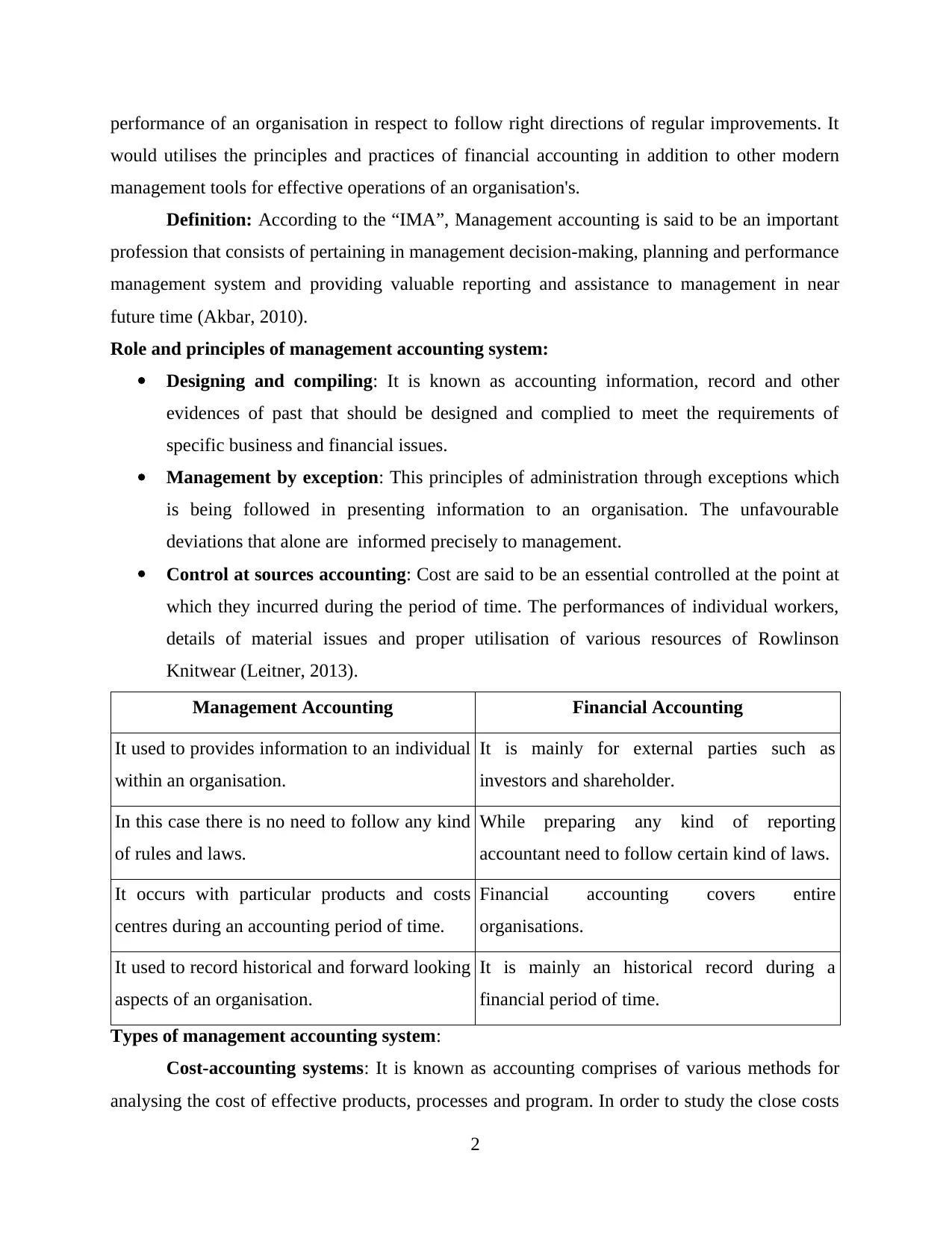
performance of an organisation in respect to follow right directions of regular improvements. It
would utilises the principles and practices of financial accounting in addition to other modern
management tools for effective operations of an organisation's.
Definition: According to the “IMA”, Management accounting is said to be an important
profession that consists of pertaining in management decision-making, planning and performance
management system and providing valuable reporting and assistance to management in near
future time (Akbar, 2010).
Role and principles of management accounting system:
Designing and compiling: It is known as accounting information, record and other
evidences of past that should be designed and complied to meet the requirements of
specific business and financial issues.
Management by exception: This principles of administration through exceptions which
is being followed in presenting information to an organisation. The unfavourable
deviations that alone are informed precisely to management.
Control at sources accounting: Cost are said to be an essential controlled at the point at
which they incurred during the period of time. The performances of individual workers,
details of material issues and proper utilisation of various resources of Rowlinson
Knitwear (Leitner, 2013).
Management Accounting Financial Accounting
It used to provides information to an individual
within an organisation.
It is mainly for external parties such as
investors and shareholder.
In this case there is no need to follow any kind
of rules and laws.
While preparing any kind of reporting
accountant need to follow certain kind of laws.
It occurs with particular products and costs
centres during an accounting period of time.
Financial accounting covers entire
organisations.
It used to record historical and forward looking
aspects of an organisation.
It is mainly an historical record during a
financial period of time.
Types of management accounting system:
Cost-accounting systems: It is known as accounting comprises of various methods for
analysing the cost of effective products, processes and program. In order to study the close costs
2
would utilises the principles and practices of financial accounting in addition to other modern
management tools for effective operations of an organisation's.
Definition: According to the “IMA”, Management accounting is said to be an important
profession that consists of pertaining in management decision-making, planning and performance
management system and providing valuable reporting and assistance to management in near
future time (Akbar, 2010).
Role and principles of management accounting system:
Designing and compiling: It is known as accounting information, record and other
evidences of past that should be designed and complied to meet the requirements of
specific business and financial issues.
Management by exception: This principles of administration through exceptions which
is being followed in presenting information to an organisation. The unfavourable
deviations that alone are informed precisely to management.
Control at sources accounting: Cost are said to be an essential controlled at the point at
which they incurred during the period of time. The performances of individual workers,
details of material issues and proper utilisation of various resources of Rowlinson
Knitwear (Leitner, 2013).
Management Accounting Financial Accounting
It used to provides information to an individual
within an organisation.
It is mainly for external parties such as
investors and shareholder.
In this case there is no need to follow any kind
of rules and laws.
While preparing any kind of reporting
accountant need to follow certain kind of laws.
It occurs with particular products and costs
centres during an accounting period of time.
Financial accounting covers entire
organisations.
It used to record historical and forward looking
aspects of an organisation.
It is mainly an historical record during a
financial period of time.
Types of management accounting system:
Cost-accounting systems: It is known as accounting comprises of various methods for
analysing the cost of effective products, processes and program. In order to study the close costs
2
Paraphrase This Document
Need a fresh take? Get an instant paraphrase of this document with our AI Paraphraser

and sum on the financial statements to support management in taking decision in more valuable
manner. There are various aspects such as:
Normal costing: It is used to determine production of goods with actual cost of material,
labour and overhead that are based on pre-determine production rate.
Standard costing: It is one of the practice of substituting an expected costs for an actual
costs in record of accounting informations.
Actual costing: These are related with various factors such as actual costs of material,
labour and overhead rate (Hilton and Platt, 2013).
Inventory management systems: It refers to an effective method of supervision and
controlling orders, storage and use of parts that a companies uses in production of a products
those are sell during the period of time. There are various techniques such as:
LIFO: It is an assets management and valuation techniques that assumes to produce or
acquire previous stock are need to be used first.
FIFO: It is appropriate methods of accounting that assumes that the oldest stock which is
sold at first.
Job-costing systems: It is an order specific estimation process which is used in situations
where each job which is different and is performed as per the customers needs. There are various
costing systems such as:
Batch costing: It is a kind of particular order costing which is more similar to job
costing. Each batch are a wide number of identical units that are relevantly different from
one another.
Process costing: It is usually an important aspects which is related with assigning costs
to units of production in companies those are producing wide amount of products.
Price-optimising systems: It is the appropriate utilisation of numerical process through
which a company need to find out how buyers will react for various prices those are being set for
different products (Ward, 2012).
M1: Benefits of management accounting system
In accordance to take appropriate decision, managers need to make use of best accounting
systems those are helpful increase profitability of an organisation in near future period of time.
There are certain benefits that are related with the departments are, determine the aims and
objectives that are being set by company for upcoming period of time. Reduction of cost is
3
manner. There are various aspects such as:
Normal costing: It is used to determine production of goods with actual cost of material,
labour and overhead that are based on pre-determine production rate.
Standard costing: It is one of the practice of substituting an expected costs for an actual
costs in record of accounting informations.
Actual costing: These are related with various factors such as actual costs of material,
labour and overhead rate (Hilton and Platt, 2013).
Inventory management systems: It refers to an effective method of supervision and
controlling orders, storage and use of parts that a companies uses in production of a products
those are sell during the period of time. There are various techniques such as:
LIFO: It is an assets management and valuation techniques that assumes to produce or
acquire previous stock are need to be used first.
FIFO: It is appropriate methods of accounting that assumes that the oldest stock which is
sold at first.
Job-costing systems: It is an order specific estimation process which is used in situations
where each job which is different and is performed as per the customers needs. There are various
costing systems such as:
Batch costing: It is a kind of particular order costing which is more similar to job
costing. Each batch are a wide number of identical units that are relevantly different from
one another.
Process costing: It is usually an important aspects which is related with assigning costs
to units of production in companies those are producing wide amount of products.
Price-optimising systems: It is the appropriate utilisation of numerical process through
which a company need to find out how buyers will react for various prices those are being set for
different products (Ward, 2012).
M1: Benefits of management accounting system
In accordance to take appropriate decision, managers need to make use of best accounting
systems those are helpful increase profitability of an organisation in near future period of time.
There are certain benefits that are related with the departments are, determine the aims and
objectives that are being set by company for upcoming period of time. Reduction of cost is
3
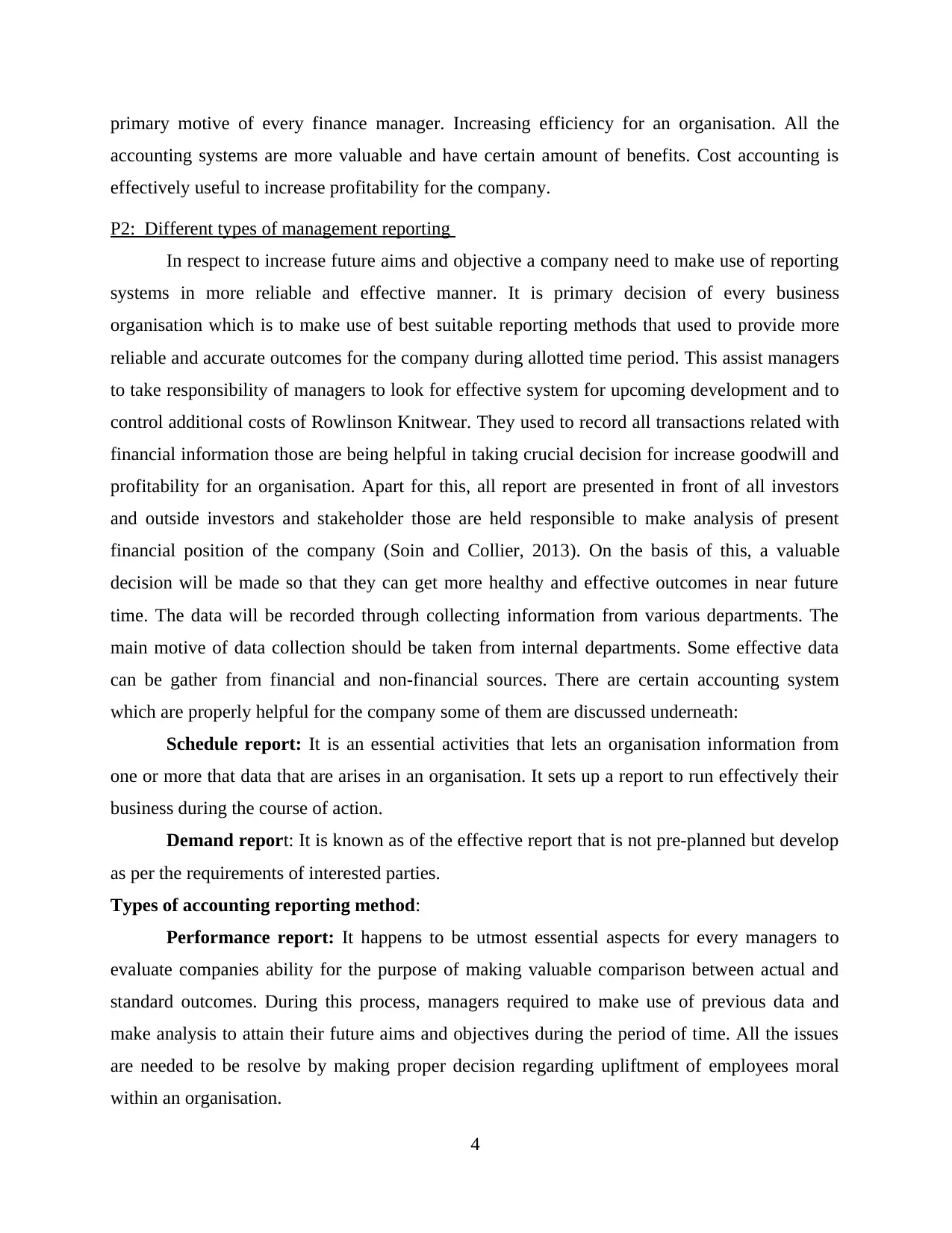
primary motive of every finance manager. Increasing efficiency for an organisation. All the
accounting systems are more valuable and have certain amount of benefits. Cost accounting is
effectively useful to increase profitability for the company.
P2: Different types of management reporting
In respect to increase future aims and objective a company need to make use of reporting
systems in more reliable and effective manner. It is primary decision of every business
organisation which is to make use of best suitable reporting methods that used to provide more
reliable and accurate outcomes for the company during allotted time period. This assist managers
to take responsibility of managers to look for effective system for upcoming development and to
control additional costs of Rowlinson Knitwear. They used to record all transactions related with
financial information those are being helpful in taking crucial decision for increase goodwill and
profitability for an organisation. Apart for this, all report are presented in front of all investors
and outside investors and stakeholder those are held responsible to make analysis of present
financial position of the company (Soin and Collier, 2013). On the basis of this, a valuable
decision will be made so that they can get more healthy and effective outcomes in near future
time. The data will be recorded through collecting information from various departments. The
main motive of data collection should be taken from internal departments. Some effective data
can be gather from financial and non-financial sources. There are certain accounting system
which are properly helpful for the company some of them are discussed underneath:
Schedule report: It is an essential activities that lets an organisation information from
one or more that data that are arises in an organisation. It sets up a report to run effectively their
business during the course of action.
Demand report: It is known as of the effective report that is not pre-planned but develop
as per the requirements of interested parties.
Types of accounting reporting method:
Performance report: It happens to be utmost essential aspects for every managers to
evaluate companies ability for the purpose of making valuable comparison between actual and
standard outcomes. During this process, managers required to make use of previous data and
make analysis to attain their future aims and objectives during the period of time. All the issues
are needed to be resolve by making proper decision regarding upliftment of employees moral
within an organisation.
4
accounting systems are more valuable and have certain amount of benefits. Cost accounting is
effectively useful to increase profitability for the company.
P2: Different types of management reporting
In respect to increase future aims and objective a company need to make use of reporting
systems in more reliable and effective manner. It is primary decision of every business
organisation which is to make use of best suitable reporting methods that used to provide more
reliable and accurate outcomes for the company during allotted time period. This assist managers
to take responsibility of managers to look for effective system for upcoming development and to
control additional costs of Rowlinson Knitwear. They used to record all transactions related with
financial information those are being helpful in taking crucial decision for increase goodwill and
profitability for an organisation. Apart for this, all report are presented in front of all investors
and outside investors and stakeholder those are held responsible to make analysis of present
financial position of the company (Soin and Collier, 2013). On the basis of this, a valuable
decision will be made so that they can get more healthy and effective outcomes in near future
time. The data will be recorded through collecting information from various departments. The
main motive of data collection should be taken from internal departments. Some effective data
can be gather from financial and non-financial sources. There are certain accounting system
which are properly helpful for the company some of them are discussed underneath:
Schedule report: It is an essential activities that lets an organisation information from
one or more that data that are arises in an organisation. It sets up a report to run effectively their
business during the course of action.
Demand report: It is known as of the effective report that is not pre-planned but develop
as per the requirements of interested parties.
Types of accounting reporting method:
Performance report: It happens to be utmost essential aspects for every managers to
evaluate companies ability for the purpose of making valuable comparison between actual and
standard outcomes. During this process, managers required to make use of previous data and
make analysis to attain their future aims and objectives during the period of time. All the issues
are needed to be resolve by making proper decision regarding upliftment of employees moral
within an organisation.
4
⊘ This is a preview!⊘
Do you want full access?
Subscribe today to unlock all pages.

Trusted by 1+ million students worldwide
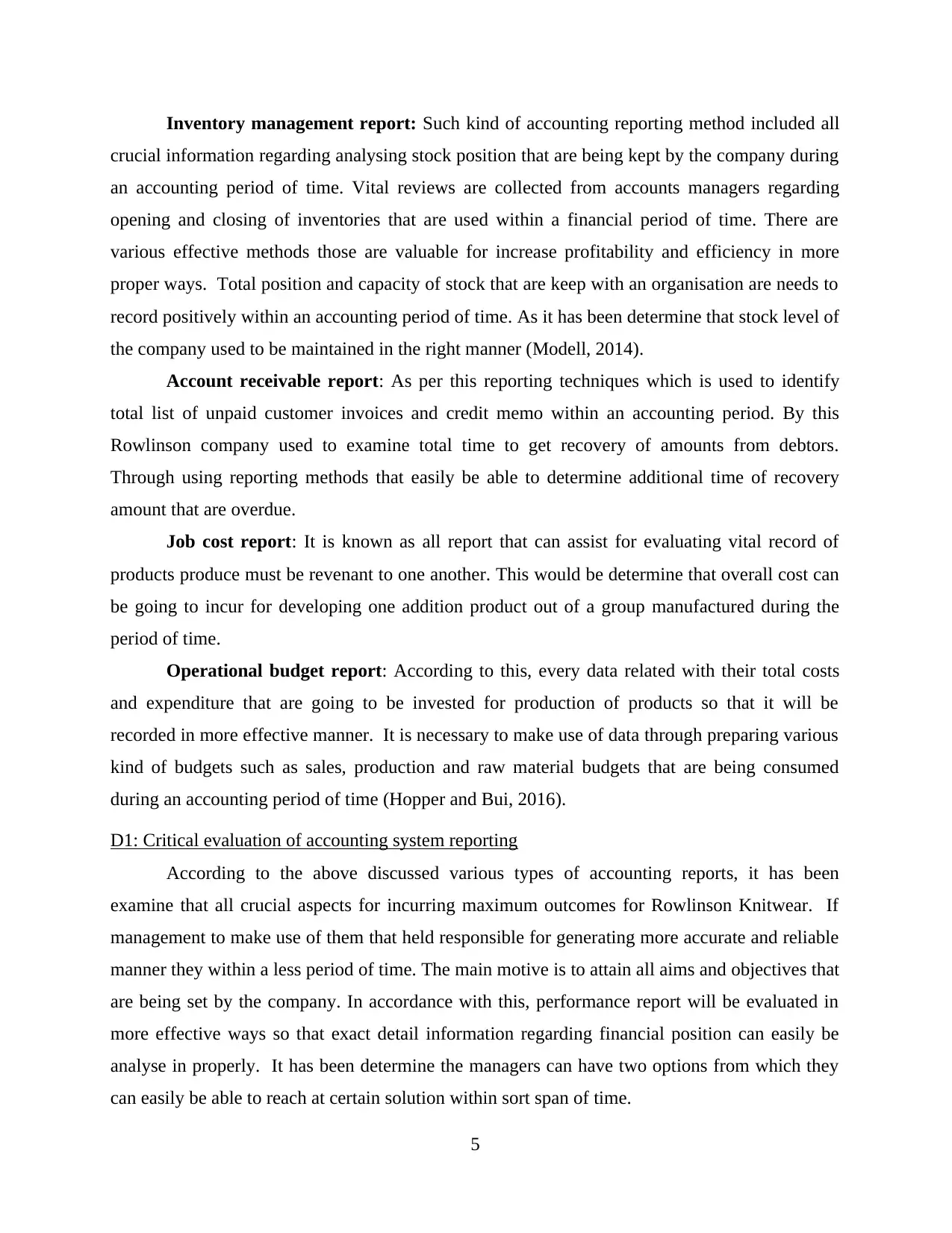
Inventory management report: Such kind of accounting reporting method included all
crucial information regarding analysing stock position that are being kept by the company during
an accounting period of time. Vital reviews are collected from accounts managers regarding
opening and closing of inventories that are used within a financial period of time. There are
various effective methods those are valuable for increase profitability and efficiency in more
proper ways. Total position and capacity of stock that are keep with an organisation are needs to
record positively within an accounting period of time. As it has been determine that stock level of
the company used to be maintained in the right manner (Modell, 2014).
Account receivable report: As per this reporting techniques which is used to identify
total list of unpaid customer invoices and credit memo within an accounting period. By this
Rowlinson company used to examine total time to get recovery of amounts from debtors.
Through using reporting methods that easily be able to determine additional time of recovery
amount that are overdue.
Job cost report: It is known as all report that can assist for evaluating vital record of
products produce must be revenant to one another. This would be determine that overall cost can
be going to incur for developing one addition product out of a group manufactured during the
period of time.
Operational budget report: According to this, every data related with their total costs
and expenditure that are going to be invested for production of products so that it will be
recorded in more effective manner. It is necessary to make use of data through preparing various
kind of budgets such as sales, production and raw material budgets that are being consumed
during an accounting period of time (Hopper and Bui, 2016).
D1: Critical evaluation of accounting system reporting
According to the above discussed various types of accounting reports, it has been
examine that all crucial aspects for incurring maximum outcomes for Rowlinson Knitwear. If
management to make use of them that held responsible for generating more accurate and reliable
manner they within a less period of time. The main motive is to attain all aims and objectives that
are being set by the company. In accordance with this, performance report will be evaluated in
more effective ways so that exact detail information regarding financial position can easily be
analyse in properly. It has been determine the managers can have two options from which they
can easily be able to reach at certain solution within sort span of time.
5
crucial information regarding analysing stock position that are being kept by the company during
an accounting period of time. Vital reviews are collected from accounts managers regarding
opening and closing of inventories that are used within a financial period of time. There are
various effective methods those are valuable for increase profitability and efficiency in more
proper ways. Total position and capacity of stock that are keep with an organisation are needs to
record positively within an accounting period of time. As it has been determine that stock level of
the company used to be maintained in the right manner (Modell, 2014).
Account receivable report: As per this reporting techniques which is used to identify
total list of unpaid customer invoices and credit memo within an accounting period. By this
Rowlinson company used to examine total time to get recovery of amounts from debtors.
Through using reporting methods that easily be able to determine additional time of recovery
amount that are overdue.
Job cost report: It is known as all report that can assist for evaluating vital record of
products produce must be revenant to one another. This would be determine that overall cost can
be going to incur for developing one addition product out of a group manufactured during the
period of time.
Operational budget report: According to this, every data related with their total costs
and expenditure that are going to be invested for production of products so that it will be
recorded in more effective manner. It is necessary to make use of data through preparing various
kind of budgets such as sales, production and raw material budgets that are being consumed
during an accounting period of time (Hopper and Bui, 2016).
D1: Critical evaluation of accounting system reporting
According to the above discussed various types of accounting reports, it has been
examine that all crucial aspects for incurring maximum outcomes for Rowlinson Knitwear. If
management to make use of them that held responsible for generating more accurate and reliable
manner they within a less period of time. The main motive is to attain all aims and objectives that
are being set by the company. In accordance with this, performance report will be evaluated in
more effective ways so that exact detail information regarding financial position can easily be
analyse in properly. It has been determine the managers can have two options from which they
can easily be able to reach at certain solution within sort span of time.
5
Paraphrase This Document
Need a fresh take? Get an instant paraphrase of this document with our AI Paraphraser
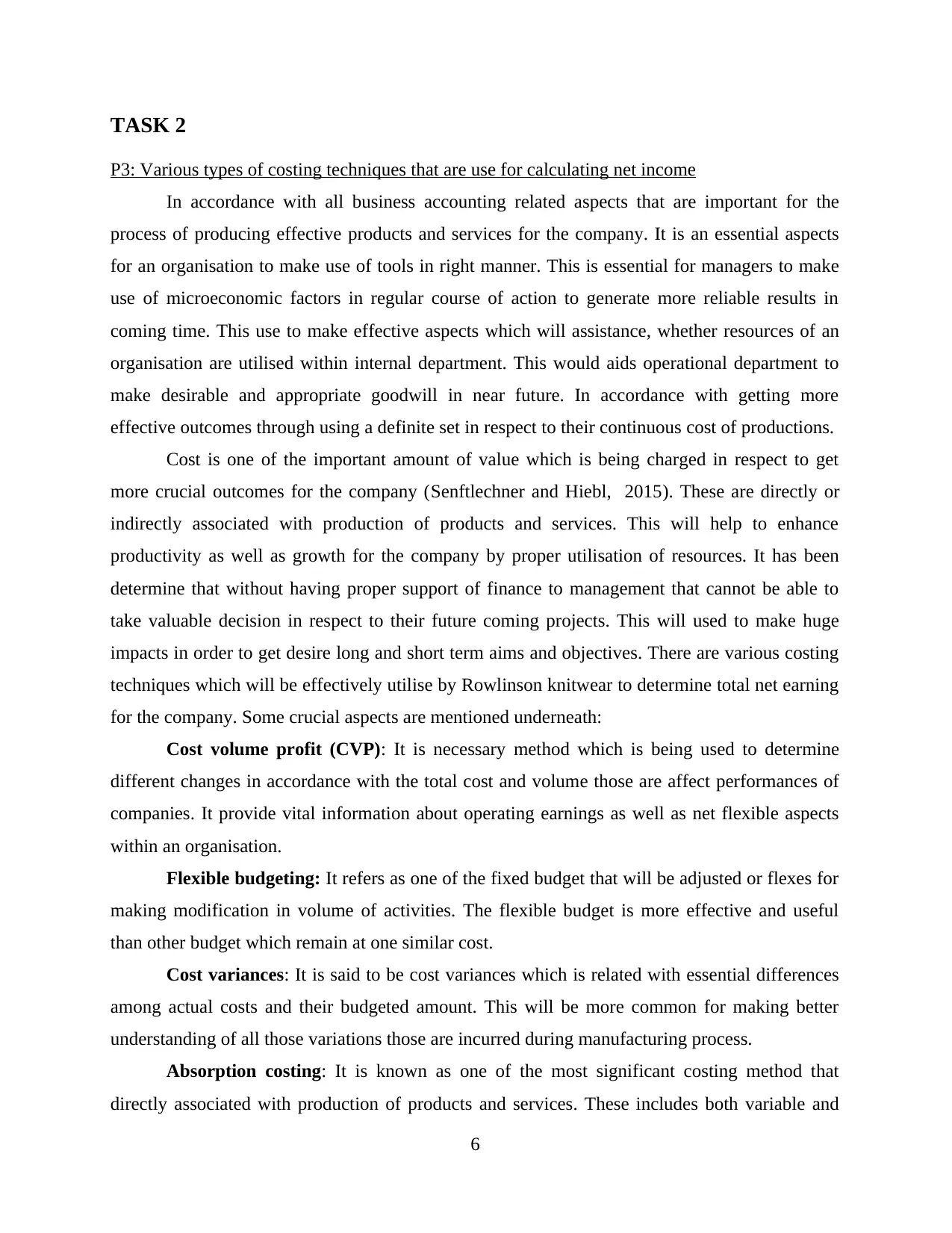
TASK 2
P3: Various types of costing techniques that are use for calculating net income
In accordance with all business accounting related aspects that are important for the
process of producing effective products and services for the company. It is an essential aspects
for an organisation to make use of tools in right manner. This is essential for managers to make
use of microeconomic factors in regular course of action to generate more reliable results in
coming time. This use to make effective aspects which will assistance, whether resources of an
organisation are utilised within internal department. This would aids operational department to
make desirable and appropriate goodwill in near future. In accordance with getting more
effective outcomes through using a definite set in respect to their continuous cost of productions.
Cost is one of the important amount of value which is being charged in respect to get
more crucial outcomes for the company (Senftlechner and Hiebl, 2015). These are directly or
indirectly associated with production of products and services. This will help to enhance
productivity as well as growth for the company by proper utilisation of resources. It has been
determine that without having proper support of finance to management that cannot be able to
take valuable decision in respect to their future coming projects. This will used to make huge
impacts in order to get desire long and short term aims and objectives. There are various costing
techniques which will be effectively utilise by Rowlinson knitwear to determine total net earning
for the company. Some crucial aspects are mentioned underneath:
Cost volume profit (CVP): It is necessary method which is being used to determine
different changes in accordance with the total cost and volume those are affect performances of
companies. It provide vital information about operating earnings as well as net flexible aspects
within an organisation.
Flexible budgeting: It refers as one of the fixed budget that will be adjusted or flexes for
making modification in volume of activities. The flexible budget is more effective and useful
than other budget which remain at one similar cost.
Cost variances: It is said to be cost variances which is related with essential differences
among actual costs and their budgeted amount. This will be more common for making better
understanding of all those variations those are incurred during manufacturing process.
Absorption costing: It is known as one of the most significant costing method that
directly associated with production of products and services. These includes both variable and
6
P3: Various types of costing techniques that are use for calculating net income
In accordance with all business accounting related aspects that are important for the
process of producing effective products and services for the company. It is an essential aspects
for an organisation to make use of tools in right manner. This is essential for managers to make
use of microeconomic factors in regular course of action to generate more reliable results in
coming time. This use to make effective aspects which will assistance, whether resources of an
organisation are utilised within internal department. This would aids operational department to
make desirable and appropriate goodwill in near future. In accordance with getting more
effective outcomes through using a definite set in respect to their continuous cost of productions.
Cost is one of the important amount of value which is being charged in respect to get
more crucial outcomes for the company (Senftlechner and Hiebl, 2015). These are directly or
indirectly associated with production of products and services. This will help to enhance
productivity as well as growth for the company by proper utilisation of resources. It has been
determine that without having proper support of finance to management that cannot be able to
take valuable decision in respect to their future coming projects. This will used to make huge
impacts in order to get desire long and short term aims and objectives. There are various costing
techniques which will be effectively utilise by Rowlinson knitwear to determine total net earning
for the company. Some crucial aspects are mentioned underneath:
Cost volume profit (CVP): It is necessary method which is being used to determine
different changes in accordance with the total cost and volume those are affect performances of
companies. It provide vital information about operating earnings as well as net flexible aspects
within an organisation.
Flexible budgeting: It refers as one of the fixed budget that will be adjusted or flexes for
making modification in volume of activities. The flexible budget is more effective and useful
than other budget which remain at one similar cost.
Cost variances: It is said to be cost variances which is related with essential differences
among actual costs and their budgeted amount. This will be more common for making better
understanding of all those variations those are incurred during manufacturing process.
Absorption costing: It is known as one of the most significant costing method that
directly associated with production of products and services. These includes both variable and
6

fixed cost during the same point of time. Because of this aspects, it is known as full costing
method. It is not so effective to make future decision-making (Absorption costing, 2018).
Marginal costing: It said to utmost costing method which is useful for manufacturing of
one additional units during the time. It consists of only variable cost and fixed costs are
apportioned. This is more reliable as compare to absorptions costs in terms of decision-making.
Income statement on the basis of Marginal costing method:
Working 1: Calculate variable production cost £
Direct material cost 8
Direct labour cost 5
Variable production O/h 2
Variable production cost 15
Working 2: Calculate value of inventory and production
Opening inventory Production Closing inventory
Nil 2000*15 = 30000 500*15 = 7500
Net profit using marginal costing £Amount £ Amount
Sales value
Less: Variable costs
Stock at the beginning
Cost of production
Stock at the closing
Variable sales overheads
Contribution
Less: Fixed costs:
Fixed Production overheads
Fixed Selling overheads
NIL
30000
(7500)
15000
10000
52500
(22500)
(7875)
22125
(25000)
7
method. It is not so effective to make future decision-making (Absorption costing, 2018).
Marginal costing: It said to utmost costing method which is useful for manufacturing of
one additional units during the time. It consists of only variable cost and fixed costs are
apportioned. This is more reliable as compare to absorptions costs in terms of decision-making.
Income statement on the basis of Marginal costing method:
Working 1: Calculate variable production cost £
Direct material cost 8
Direct labour cost 5
Variable production O/h 2
Variable production cost 15
Working 2: Calculate value of inventory and production
Opening inventory Production Closing inventory
Nil 2000*15 = 30000 500*15 = 7500
Net profit using marginal costing £Amount £ Amount
Sales value
Less: Variable costs
Stock at the beginning
Cost of production
Stock at the closing
Variable sales overheads
Contribution
Less: Fixed costs:
Fixed Production overheads
Fixed Selling overheads
NIL
30000
(7500)
15000
10000
52500
(22500)
(7875)
22125
(25000)
7
⊘ This is a preview!⊘
Do you want full access?
Subscribe today to unlock all pages.

Trusted by 1+ million students worldwide
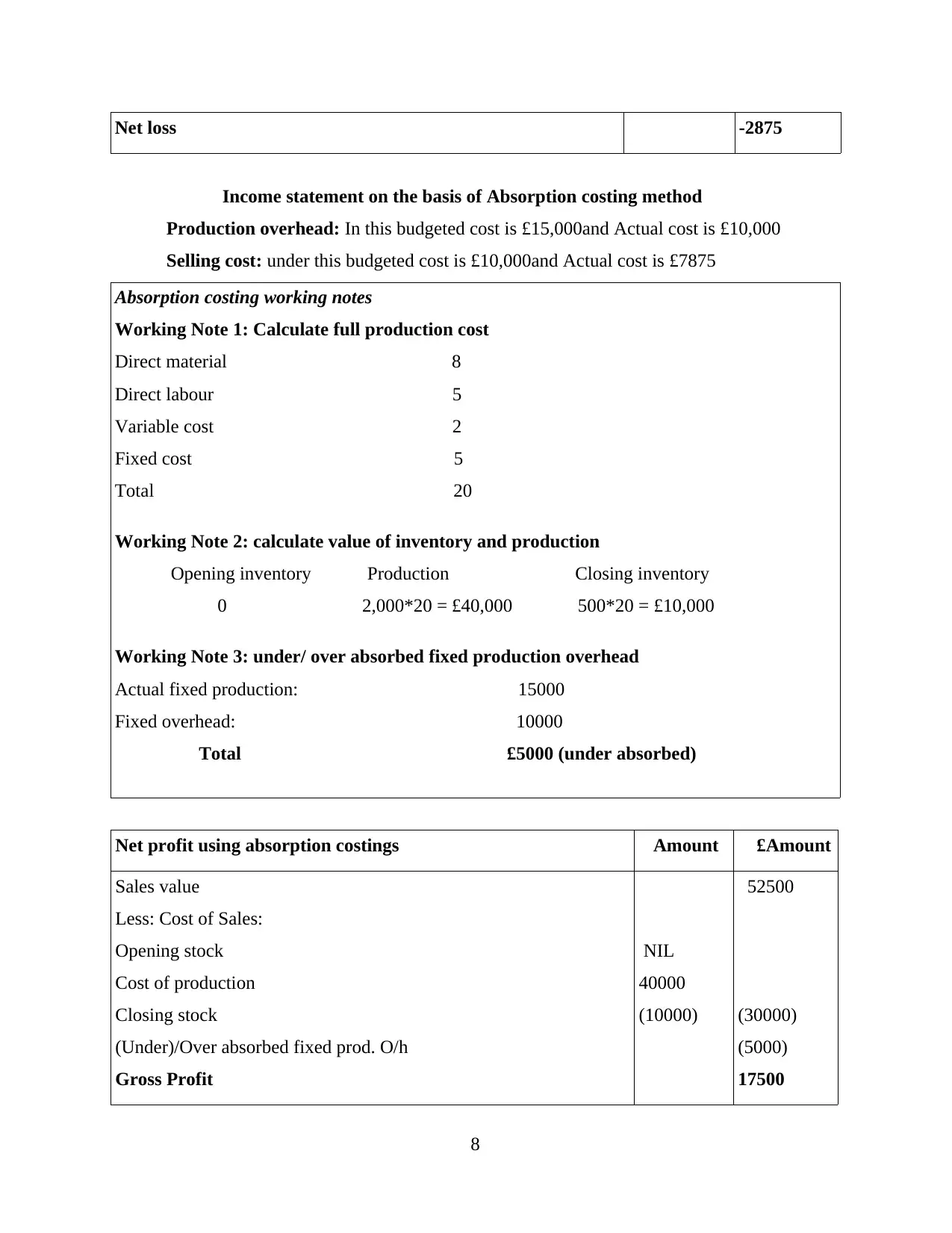
Net loss -2875
Income statement on the basis of Absorption costing method
Production overhead: In this budgeted cost is £15,000and Actual cost is £10,000
Selling cost: under this budgeted cost is £10,000and Actual cost is £7875
Absorption costing working notes
Working Note 1: Calculate full production cost
Direct material £8
Direct labour £5
Variable cost £2
Fixed cost £5
Total £20
Working Note 2: calculate value of inventory and production
Opening inventory Production Closing inventory
0 2,000*20 = £40,000 500*20 = £10,000
Working Note 3: under/ over absorbed fixed production overhead
Actual fixed production: £15000
Fixed overhead: £10000
Total £5000 (under absorbed)
Net profit using absorption costings £Amount £Amount
Sales value
Less: Cost of Sales:
Opening stock
Cost of production
Closing stock
(Under)/Over absorbed fixed prod. O/h
Gross Profit
NIL
40000
(10000)
52500
(30000)
(5000)
17500
8
Income statement on the basis of Absorption costing method
Production overhead: In this budgeted cost is £15,000and Actual cost is £10,000
Selling cost: under this budgeted cost is £10,000and Actual cost is £7875
Absorption costing working notes
Working Note 1: Calculate full production cost
Direct material £8
Direct labour £5
Variable cost £2
Fixed cost £5
Total £20
Working Note 2: calculate value of inventory and production
Opening inventory Production Closing inventory
0 2,000*20 = £40,000 500*20 = £10,000
Working Note 3: under/ over absorbed fixed production overhead
Actual fixed production: £15000
Fixed overhead: £10000
Total £5000 (under absorbed)
Net profit using absorption costings £Amount £Amount
Sales value
Less: Cost of Sales:
Opening stock
Cost of production
Closing stock
(Under)/Over absorbed fixed prod. O/h
Gross Profit
NIL
40000
(10000)
52500
(30000)
(5000)
17500
8
Paraphrase This Document
Need a fresh take? Get an instant paraphrase of this document with our AI Paraphraser
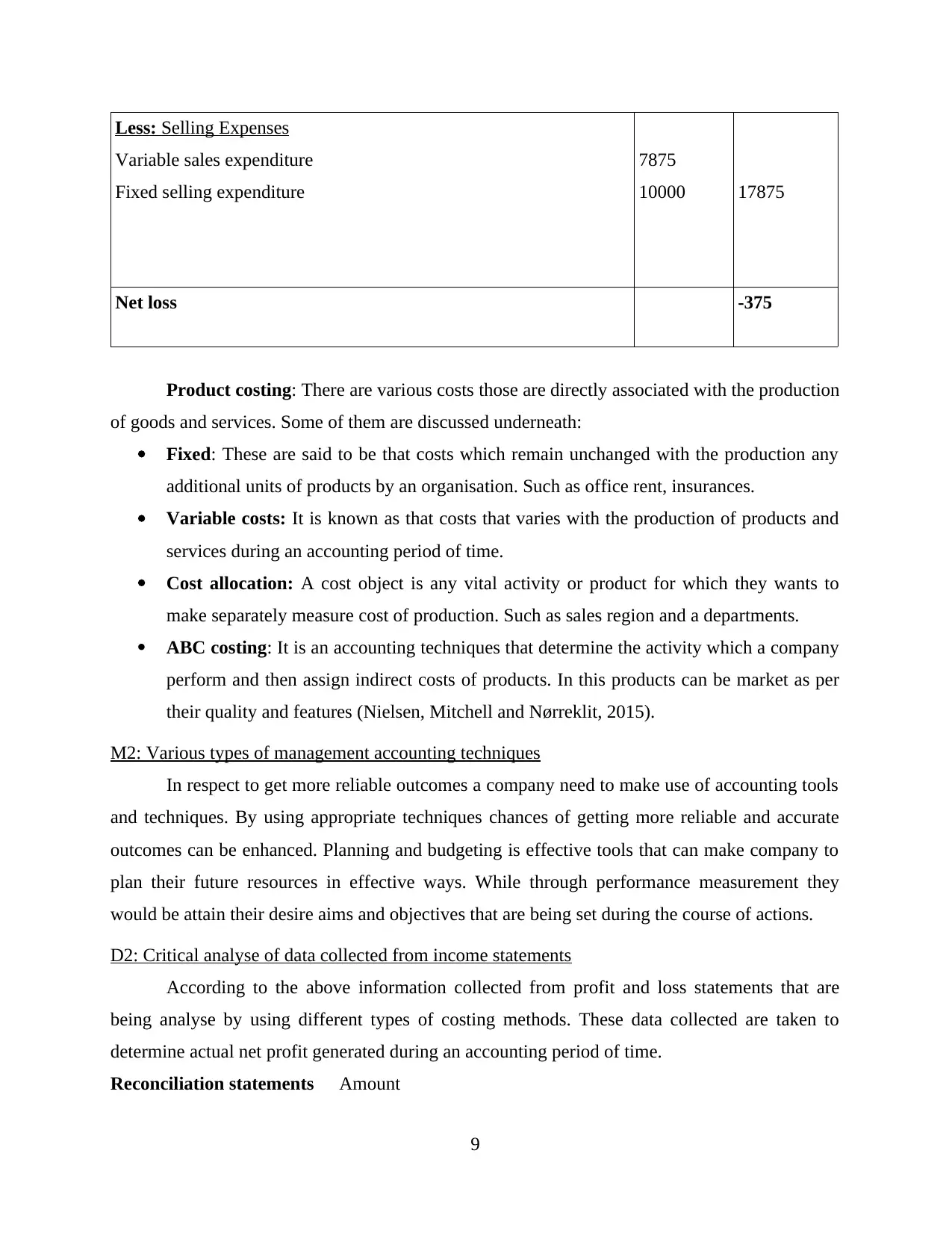
Less: Selling Expenses
Variable sales expenditure
Fixed selling expenditure
7875
10000 17875
Net loss -375
Product costing: There are various costs those are directly associated with the production
of goods and services. Some of them are discussed underneath:
Fixed: These are said to be that costs which remain unchanged with the production any
additional units of products by an organisation. Such as office rent, insurances.
Variable costs: It is known as that costs that varies with the production of products and
services during an accounting period of time.
Cost allocation: A cost object is any vital activity or product for which they wants to
make separately measure cost of production. Such as sales region and a departments.
ABC costing: It is an accounting techniques that determine the activity which a company
perform and then assign indirect costs of products. In this products can be market as per
their quality and features (Nielsen, Mitchell and Nørreklit, 2015).
M2: Various types of management accounting techniques
In respect to get more reliable outcomes a company need to make use of accounting tools
and techniques. By using appropriate techniques chances of getting more reliable and accurate
outcomes can be enhanced. Planning and budgeting is effective tools that can make company to
plan their future resources in effective ways. While through performance measurement they
would be attain their desire aims and objectives that are being set during the course of actions.
D2: Critical analyse of data collected from income statements
According to the above information collected from profit and loss statements that are
being analyse by using different types of costing methods. These data collected are taken to
determine actual net profit generated during an accounting period of time.
Reconciliation statements Amount
9
Variable sales expenditure
Fixed selling expenditure
7875
10000 17875
Net loss -375
Product costing: There are various costs those are directly associated with the production
of goods and services. Some of them are discussed underneath:
Fixed: These are said to be that costs which remain unchanged with the production any
additional units of products by an organisation. Such as office rent, insurances.
Variable costs: It is known as that costs that varies with the production of products and
services during an accounting period of time.
Cost allocation: A cost object is any vital activity or product for which they wants to
make separately measure cost of production. Such as sales region and a departments.
ABC costing: It is an accounting techniques that determine the activity which a company
perform and then assign indirect costs of products. In this products can be market as per
their quality and features (Nielsen, Mitchell and Nørreklit, 2015).
M2: Various types of management accounting techniques
In respect to get more reliable outcomes a company need to make use of accounting tools
and techniques. By using appropriate techniques chances of getting more reliable and accurate
outcomes can be enhanced. Planning and budgeting is effective tools that can make company to
plan their future resources in effective ways. While through performance measurement they
would be attain their desire aims and objectives that are being set during the course of actions.
D2: Critical analyse of data collected from income statements
According to the above information collected from profit and loss statements that are
being analyse by using different types of costing methods. These data collected are taken to
determine actual net profit generated during an accounting period of time.
Reconciliation statements Amount
9

Profit under absorption -375
Closing stock 500*5 2500
Profit under marginal 2125
From the above table, it has been determine that profit generated from absorption
collected during the time is showing negative outcomes with -375. The point of differences are
seen because of fixed cost adjustments.
TASK 3
P4: Merit and demerits of using planning tools use in budgets
Planning is an essential aspects which are needed to be taken into consideration. All the
mentioned tools are effectively responsible for increasing productivity as well as efficiency with
using proper outcomes for the company. Some of the effective budgets are:
Operational budget: It is known as one of the primary budget which depend upon effective
decision-making collected from total revenue collected out of their functional operations of an
organisation.
Advantages: This seems to be more reliable for managers those are responsible for
producing products for the company. Some of them are sales, production and purchase budgets.
Disadvantage: This happens to be more time consuming while making reporting for the
company..
Rolling budget: It refers to continuous update that included into a new budget time framework
as more recent period completion. It consists of incremental extensions of current budget model.
Advantage: This particular assumption would be helpful to formulate maximum value
for forecasting to the company.
Disadvantage: It seems to be more time consuming while preparing budgets from using
general figures.
Fixed budgets: This seems to be utmost important budget that would be changes on flex during
sales or some other activities though which it can increase of decrease at the same period of time.
Advantage: The major limitation of this budgets which is being accounted for life
unpredictable activities.
Disadvantages: It has been use to analyse small business transactions that are done
during the period of time.
10
Closing stock 500*5 2500
Profit under marginal 2125
From the above table, it has been determine that profit generated from absorption
collected during the time is showing negative outcomes with -375. The point of differences are
seen because of fixed cost adjustments.
TASK 3
P4: Merit and demerits of using planning tools use in budgets
Planning is an essential aspects which are needed to be taken into consideration. All the
mentioned tools are effectively responsible for increasing productivity as well as efficiency with
using proper outcomes for the company. Some of the effective budgets are:
Operational budget: It is known as one of the primary budget which depend upon effective
decision-making collected from total revenue collected out of their functional operations of an
organisation.
Advantages: This seems to be more reliable for managers those are responsible for
producing products for the company. Some of them are sales, production and purchase budgets.
Disadvantage: This happens to be more time consuming while making reporting for the
company..
Rolling budget: It refers to continuous update that included into a new budget time framework
as more recent period completion. It consists of incremental extensions of current budget model.
Advantage: This particular assumption would be helpful to formulate maximum value
for forecasting to the company.
Disadvantage: It seems to be more time consuming while preparing budgets from using
general figures.
Fixed budgets: This seems to be utmost important budget that would be changes on flex during
sales or some other activities though which it can increase of decrease at the same period of time.
Advantage: The major limitation of this budgets which is being accounted for life
unpredictable activities.
Disadvantages: It has been use to analyse small business transactions that are done
during the period of time.
10
⊘ This is a preview!⊘
Do you want full access?
Subscribe today to unlock all pages.

Trusted by 1+ million students worldwide
1 out of 16
Related Documents
Your All-in-One AI-Powered Toolkit for Academic Success.
+13062052269
info@desklib.com
Available 24*7 on WhatsApp / Email
![[object Object]](/_next/static/media/star-bottom.7253800d.svg)
Unlock your academic potential
Copyright © 2020–2025 A2Z Services. All Rights Reserved. Developed and managed by ZUCOL.





